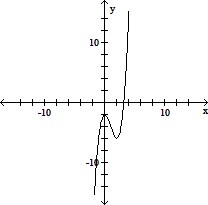Write a description of the set.E = {x | x ? N and 2 < x ? 19}
A. E is the set of natural numbers greater than 2 and less than or equal to 19.
B. E is the set of integers greater than 2 and less than or equal to 19.
C. E is the set of natural numbers greater than 19 and less than or equal to 2.
D. E is the set of natural numbers greater than or equal to 2 and less than 19.
Answer: A
You might also like to view...
Use the graph of the function f(x) to locate the local extrema and identify the intervals where the function is concave up and concave down.
A. Local minimum at x = 0; local maximum at x = 2; concave up on (0, ?); concave down on (-?, 0) B. Local minimum at x = 2; local maximum at x = 0; concave up on (0, ?); concave down on (-?, 0) C. Local minimum at x = 0; local maximum at x = 2; concave down on (0, ?); concave up on (-?, 0) D. Local minimum at x = 2; local maximum at x = 0; concave down on (0, ?); concave up on (-?, 0)
Factor the special products, which are the sum or difference of two perfect cubes.125s3 + 27t3
A. (5s + 3t)(25s2 - 15st + 9t2) B. (5s + 3t)(25s2 + 15st + 9t2) C. (5s - 3t)(25s2 - 15st + 9t2) D. (6s + 3t)(25s2 + 9t2)
Solve the problem.If the average cost per unit C(x) to produce x units of plywood is given by C(x) =  , what is the unit cost for 40 units?
, what is the unit cost for 40 units?
A. $0.75 B. $-12.50 C. $37.50 D. $16.67
Solve the problem.The approximate monthly average temperatures in degrees Fahrenheit in a certain city can be approximated by the function f(x) = -0.005x6 + 0.31x4 - 6.14x2 + 83with domain {x|-6 ? x ? 6}. Here x represents the month with x = 0 corresponding to July. What is the average temperature (rounded to the nearest degree) in January?
A. 30°F B. 35°F C. 40°F D. 45°F